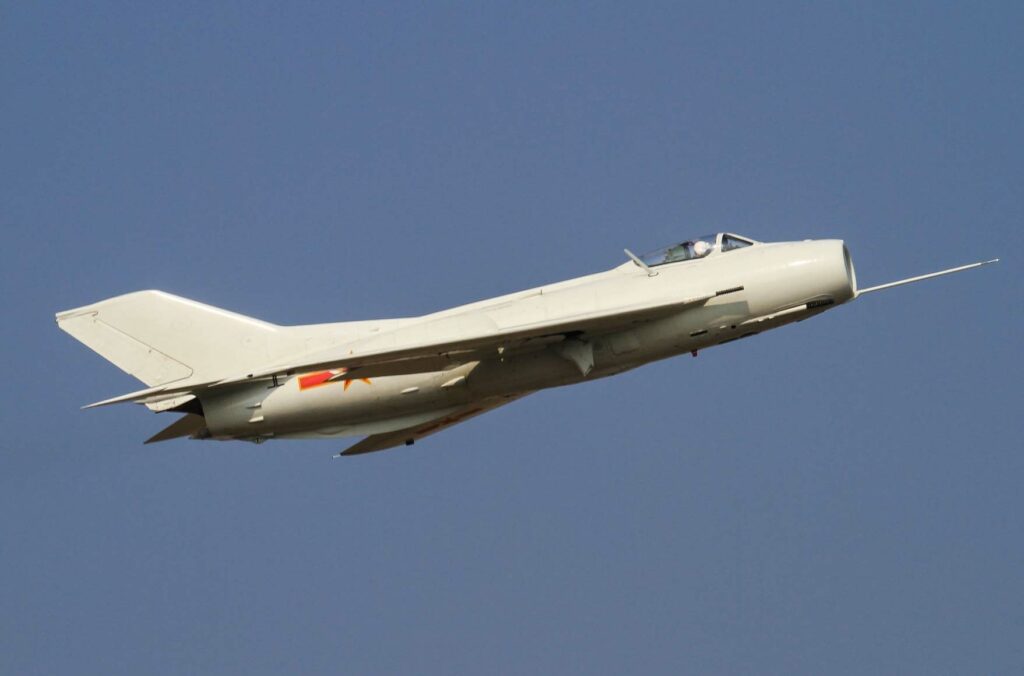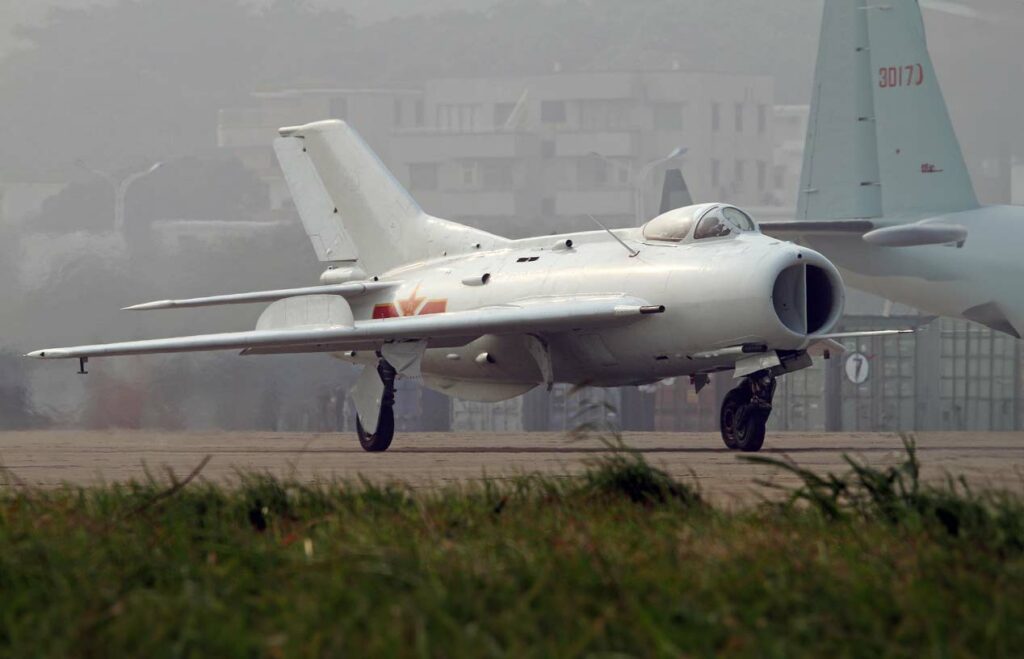The Shenyang (AVIC) J-6/F-6 is a Chinese-built version of the MiG-19 fighter, known for its supersonic speed and dual-engine design.
In brief
The Shenyang J-6/F-6, a Chinese license-produced version of the Soviet MiG-19, is a twin-engine, supersonic jet fighter developed in the late 1950s. The aircraft is powered by two WP-6 turbojet engines, enabling speeds up to Mach 1.3 (1,400 km/h; 870 mph) with a range of 2,200 km (1,367 miles) and a service ceiling of 17,500 meters (57,415 feet). It is armed with three cannons and has provisions for bombs and air-to-air missiles. The J-6 was a significant step for the People’s Liberation Army Air Force (PLAAF) in terms of adopting supersonic fighter technology, contributing to the modernization of China’s air defense capabilities during the Cold War era.

History of the Development of the Shenyang (AVIC) J-6/F-6
In the context of the Cold War, the People’s Republic of China sought to modernize its air force capabilities to defend against perceived threats and to assert its sovereignty. The J-6/F-6 was developed as part of China’s efforts to close the technology gap with Western and Soviet air forces. The program was launched following an agreement with the Soviet Union to license-produce the MiG-19, which first flew in 1953.
China’s Shenyang Aircraft Corporation, under the auspices of the Aviation Industry Corporation of China (AVIC), initiated the J-6 project to produce a domestic version of the MiG-19. The first Chinese-built J-6 flew on September 17, 1958. The aircraft was designated F-6 for its export versions. The NATO reporting name for the MiG-19 is “Farmer,” although this nickname is more commonly associated with the Soviet versions than the Chinese J-6.
The development of the J-6 was driven by the need for a high-performance, supersonic fighter that could effectively counter enemy aircraft and provide air superiority. The project aimed to enhance China’s defensive and offensive air capabilities, leveraging technology transfer from the Soviet Union to build a strong, self-reliant aerospace industry.
Design of the Shenyang (AVIC) J-6/F-6
The Shenyang J-6/F-6 design closely follows that of its Soviet counterpart, the MiG-19 “Farmer.” The aircraft features a robust, straightforward design with a conventional layout: a mid-wing configuration, a tailplane, and two WP-6 turbojet engines housed in the fuselage’s aft section. It measures 12.54 meters (41 ft 2 in) in length, with a wingspan of 9.2 meters (30 ft 2 in) and a height of 3.9 meters (12 ft 10 in).
The J-6’s airframe was designed for durability and ease of production, with an emphasis on providing a stable platform for high-speed flight and combat maneuverability. Its armament includes three 30 mm cannons and provisions for an array of air-to-air missiles and bombs, enabling it to engage a variety of targets effectively.
One of the key advantages of the J-6 was its simplicity and reliability, which made it suitable for mass production and operation under varying conditions. However, its drawbacks included limited avionics capabilities and a relatively high fuel consumption rate, which constrained its operational range and mission flexibility compared to more advanced fighters.
Performance of the Shenyang (AVIC) J-6/F-6
The J-6/F-6’s performance characteristics reflect its role as an early supersonic fighter. It can reach a top speed of Mach 1.3 (approximately 1,400 km/h; 870 mph) and has a service ceiling of 17,500 meters (57,415 feet). The aircraft’s range is about 2,200 km (1,367 miles) with external fuel tanks, allowing for extended operations beyond its base.
When compared to contemporaries like the American F-100 Super Sabre or the Soviet MiG-17, the J-6 offered a competitive mix of speed, agility, and firepower. Its capability to achieve supersonic speeds and its robust armament made it a formidable opponent in air-to-air combat during its era.
Variants of the Shenyang (AVIC) J-6/F-6
The J-6/F-6 saw several variants throughout its service life, including:
- J-6 (basic version): The initial production model.
- J-6A/F-6A: An improved version with enhanced avionics and weapon systems.
- J-6B: A variant equipped with an all-weather radar for improved operational capability.
- J-6III: An advanced version with improved engines and aerodynamics.
- JJ-6/Q-5: A two-seat trainer version and a ground-attack variant developed from the J-6 design.

Military Use and Combat of the Shenyang (AVIC) J-6/F-6
The J-6/F-6 was extensively used by the People’s Liberation Army Air Force (PLAAF) and exported to several allied nations, seeing action in various conflicts. It participated in air combat during the Vietnam War, where it engaged U.S. aircraft, and in border skirmishes between China and the Soviet Union in the late 1960s. The J-6’s armament and speed made it a valuable asset in these engagements, although its performance was increasingly challenged by more advanced Western aircraft.
The J-6 also saw service in the air forces of countries like Pakistan, North Korea, and Albania, among others. In the 1971 Indo-Pakistani War, Pakistani F-6s were used effectively for air-to-air combat and ground-attack missions.
Over time, the J-6 was gradually phased out and replaced by more modern aircraft, such as the J-7 (a Chinese version of the MiG-21) and later generations of Chinese fighters. However, some countries continued to operate the J-6/F-6 into the early 21st century, a testament to its durability and adaptability.
The Shenyang J-6/F-6 represents a significant chapter in the history of military aviation, marking China’s entry into the era of supersonic jet fighters. Despite its limitations, the J-6 played a crucial role in modernizing the PLAAF and served as a foundation for the development of China’s aerospace industry. Its widespread use and participation in various conflicts underscore its effectiveness as a combat aircraft. As technology advanced, the J-6’s legacy continued in the form of newer, more capable aircraft, reflecting the evolution of aerial warfare and aircraft design.
Back to the Fighter Jet section.